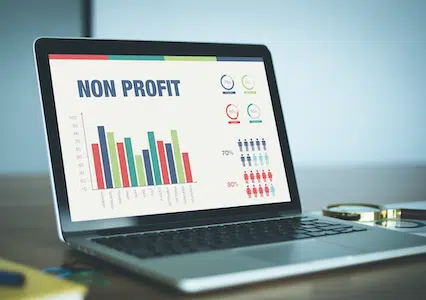
According to a recent report, the average conversion rate for a nonprofit website is only 1%. It’s sobering to think that 99% of the people who visit your site leave without subscribing, donating, or taking any other significant action. But it also means this: if you can adjust to increase the conversion rate to 2%, that’s a 100% increase in donations and subscriptions. You can accomplish this with little to no impact on your budget.
One of the best strategies to increase conversion rates is leveraging other lead generators supporting your website. Some examples are:
- Social media platforms
- Advertising campaigns
- Event planning
- SMS and email campaigns
Whether you’re printing business cards, making contacts at events, or promoting your nonprofit by means of a digital or physical campaign, a recognizable and memorable phone number is a great tool. Visit 800.com to get a vanity toll-free number or a local vanity phone number.
What Are Conversion Rates and Why Are They So Important?
Your conversion rate is a measure of success in achieving your goal as a nonprofit. It refers to the percentage of people who take action regarding your organization. For example, let’s say your site encourages donations, and on a given day, 200 people visit your site, but only 25 of them actually donate. A simple equation will give you your conversion rate for that day:
25 (donators) / 200 (visitors) = 0.125
0.125 x 100 = 12.5% (Conversion rate)
In reality, the more factors you input, the more complicated it gets. So if you’re tracking site visitors and other analytics while running various campaigns for donations, subscriptions, and other actions, it gets a little more difficult to deduce the conversion rate. But do not worry, there’s software for that.
Recent statistics show that giving is up but that many nonprofits do not have strategies in place to maximize their conversion rate.
What Methods Are Used to Analyze Conversion Rates
Many platforms will track, analyze, and display your conversion rate. Examples are Google Analytics and Ads, Facebook Ads, and Youtube Ads. There are also digital tools available, such as Click, Crazy Egg, Histats, and others. Here are some of the things tracked and analyzed:
- Exit Pages. These are the pages that most often “cause” a person to leave your site. The result is the percentage of people who leave from each respective page. This helps to identify which pages most interest visitors and which ones don’t.
- Bounce Rate. This refers to visitors who leave immediately after visiting only one page of your site. It may be caused by slow loading (impatience), poor design, or weak sources (where or what they clicked that brought them to your site).
- Average Time. The average time each user spends on each page is a good metric to indicate if they are actually interacting with your website.
- Average Views. This metric can be cut both ways. Many page views might mean a lot of interest, but conversely, it could mean that users can’t find what they’re looking for. Correlate it with the amount of time they spend on each respective page.
- Site Interaction. Some tools go farther than just measuring how much time users spend on a page. They measure the interaction with the page. For example, did they read, scroll down to the bottom, and what did they click on?
- Traffic Type. Many analytic tools will provide crucial details about your website traffic, things like demographics and traffic sources. Traffic comes from three main sources: direct (meaning they typed your website address directly into the browser), referral (they clicked a link on another site), or search (meaning they used a search engine and found your website in the results).
- Click-Thru Rate (CTR). This measures how many people click through on a displayed ad or call to action (CTA). This can exist on one of your site pages or on another platform. It measures interest in what you’re promoting thereby revealing whether or not you’re targeting the right audience with the right content.
How to Optimize Your Conversion Rate as a Nonprofit
Conversion rate optimization (CRO) is just as important for nonprofits as it is for businesses. In fact, it can be more important because a business is meeting consumer demand with supply, but a nonprofit is asking people to engage and commit to an idea, belief, or social need. So what are some of the strategies for CRO?
Value Proposition
Your nonprofit’s value proposition refers to a clear statement that explains why a person should donate or otherwise engage. It needs to be worded and placed where it will catch people’s attention quickly. This reduces the bounce rate and increases site interaction.
Homepage design can determine how strong your value proposition is. If it’s too cluttered or if it doesn’t transition well to mobile view, you could be losing your audience upfront. While overall conversion rates for nonprofits average 1%, conversion rates from mobile devices average 8%. More people are accessing the web from their mobile devices. So be sure that your site is just as engaging in mobile view to capitalize on this shift.
Goals
The goals of your nonprofit drive the purpose and content of your site. Visitors are more likely to engage if the goals and intent are clear and focused. Let’s take a look at some examples:
- Education and awareness. Your nonprofit site’s purpose may be to provide education and raise awareness for a certain issue, need, or belief system.
- Donations and sponsors. The purpose of the site may be to raise money for a cause or attract sponsors to back the activities of your organization.
- Subscriptions and lists. On the other hand, your main goal may be to build lists or generate subscriptions from followers so that you can issue notifications and alerts.
In reality, any or all of the above may be the goals of your organization. Having the goals clearly in mind will help to ensure that the design, layout, and features of your site maximize the return for each goal.
Content
The content you choose needs to be in harmony with the goals you’ve set. Think of content as a virtual path to a goal. What you want is for the content to lead users down a path toward the goal you’ve set. Each piece of content should have a CTA that pertains to the goal it is focused on.
Appeal
Even if your nonprofit has a very singular objective, your audience will be diverse across multiple demographics. So you’ll need to imagine the various personas that will interact with your site and prepare content, features, and incentives that will appeal to each one.
Build trust and credibility by displaying such things as awards, testimonials, media exposure, and quotes by experts prominently so people can see them. Toll-free numbers are also a means to building trust. Toll-free numbers are the gold standard in phone numbers for organizations, especially if your nonprofit has international appeal. 800 vanity phone numbers are easily recognizable and trustworthy.
Simplicity
Keep in mind that not all users are tech-savvy, and many have very limited time. So simplicity is the key to not losing those demographics. For example, if you use forms for signing up subscribers, keep the forms easily accessible, short, and simple. Keep your CTA’s short and to the point, and don’t forget to include vanity 800 numbers as part of a memorable CTA. A clean and easy-to-navigate website will do a lot for CRO.
Tracking
Leverage tracking and analytics with an organized, systematic approach. Create a plan. Decide exactly what you want to track for each page and feature of your site. Don’t generalize the metrics, instead fine-tune it for each page to determine if you are meeting your goals. Heatmap analysis is an excellent example of a tool for determining conversion rates. It’s a visual representation of the areas of activity on each page of your site.
Reaping the Benefits
As a nonprofit you want people to engage and to take action. Maximizing the likelihood that users will interact with your site involves various fine-tuning strategies to see what works and then being willing to monitor and adapt as it changes. Some of the tangible results will be:
- Increased subscribers and/or donors.
- Increased engagement with your audience.
- Increased awareness.
- Lower cost per conversion for your organization.
- Higher SEO results.
Toll-free numbers and vanity phone numbers are excellent tools for increasing CRO. People are more likely to call a toll-free number because there is no charge to the caller, and it’s easier to recall. What is a good vanity phone number? It is a phone number customized by a word or phrase that equals the number of digits in a phone number, for example, (555) PURE H2O or 1 800 4 A CHILD.
Being free for the caller (in the case of toll-free) and easily recognized and remembered (vanity), the likelihood of conversion is higher when they are placed on website pages, business cards, event flyers, and other marketing materials.
Try our vanity phone numbers generator to choose custom vanity phone numbers, or contact us today to find out how to get a toll-free vanity number.












